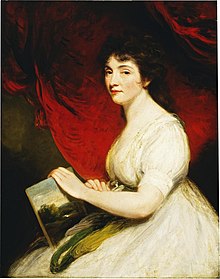Mary Linwood
| Mary Linwood | |
|---|---|

Mary Linwood, oil on canvas, c. 1800, John Hoppner
|
|
| Born | 1755 Birmingham |
| Died | 1845 London |
| Occupation | Needle woman, school mistress |
Mary Linwood (1755–1845) was a needle woman who exhibited her worsted embroidery or crewel embroidery in Leicester and London, and was the school mistress of a private school later known as Mary Linwood Comprehensive School. In 1790, she received a medal from the Society of Arts.
Born in Birmingham in 1755, Mary Linwood moved to Leicester in 1764 with her family after her father, a wine merchant, became bankrupt. He died young and her mother opened a private boarding school for young ladies in Belgrave Gate. When her mother died Mary took over the school and continued it for 50 years. Mary made her first embroidered picture when she was thirteen years old, and by 1775 had established herself as a needlework artist. By the age of 31, Mary had attracted the attention of the royal family, and she was invited to Windsor Castle by Queen Charlotte to show her work.
For nearly seventy-five years Mary worked in worsted embroidery, producing a collection of over 100 pictures that specialised in full size copies of old masters. She opened an exhibition in the Hanover Square Rooms in 1798, which afterward traveled to Leicester Square, Edinburgh and Dublin. Mary Linwood's copies of old master paintings in crewel wool (named from the crewel or worsted wool used), in which the irregular and sloping stitches resembled brushwork, achieved great fame from the time of her first London exhibition in 1787. She met most of the crowned heads of Europe. She exhibited in Russia and Catherine the Great offered £40,000 for the whole collection while the Tsar offered her £3,000 for one example. However, Mary refused as she wished her work to remain in England. On one occasion her copy of a painting by the Italian artist Salvator Rosa (1615–1673) sold for more than the original. One of Mary's own designs, the Judgement of Cain, took ten years to complete.
Her exhibition in Leicester Square, London, was the first art show to be illuminated by gaslight. The exhibition consisted of copies of paintings after such masters as Carlo Dolci, Guido, Ruisdael, Opie, Morland, Gainsborough and Reynolds. Mary's subjects also included Lady Jane Grey and Napoleon, whose portrait was said to have been done from life. He conferred on Mary the Freedom of Paris in 1803. So successful was Mary Linwood that she was able to commission John Hoppner (1758–1810) to paint the portrait on this page. By this time Hoppner was principal painter to the Prince of Wales (later George IV) and the most important portraitist in England.John Constable's (1776–1837) first commissioned work was to paint the background details in one of her works. Mary is said to have refused an offer of 3000 guineas for her version of Carlo Dolci's Salvator Mundi, and instead bequeathed it to Queen Victoria.
...
Wikipedia
